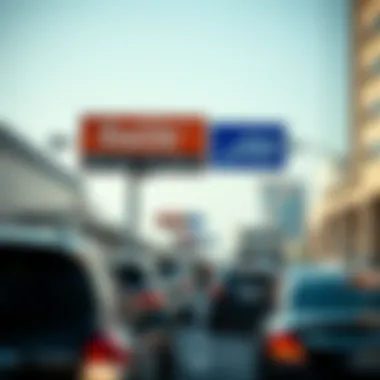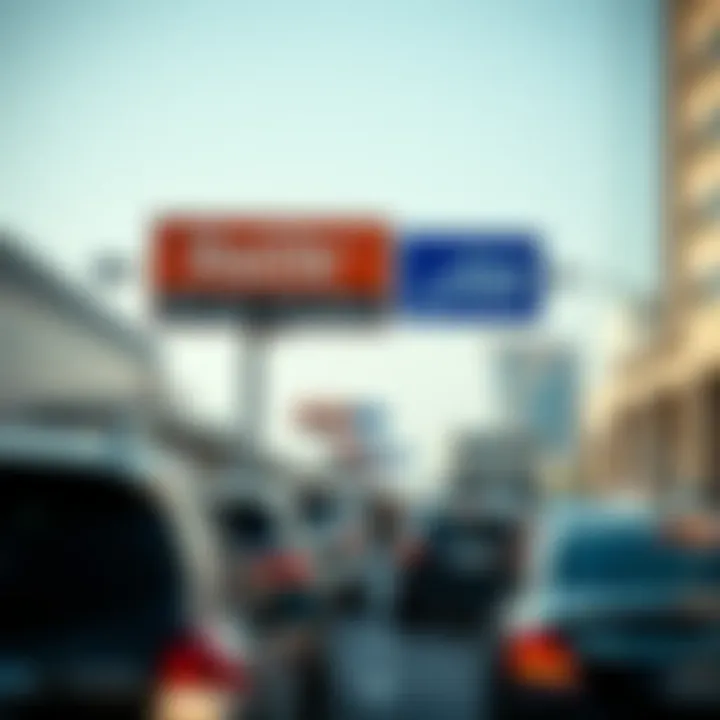Navigating the Salik System at Dubai Mall: A Guide


Intro
Navigating through Dubai, especially around its most renowned shopping hub, Dubai Mall, requires an understanding of the Salik system. This electronic toll collection system has a profound impact on traffic flow, visitors' experience, and the overall urban landscape of Dubai. As the Mall attracts millions of shoppers and tourists each year, comprehending how Salik influences mobility can enhance one’s experience and ease congestion during peak hours.
The Salik system was introduced to streamline traffic and reduce delays in key areas of the city. More than just a toll system, it represents a facet of Dubai's strategic urban planning, reflecting on growth and accessibility. With Dubai Mall being a central point of attraction, it’s essential to grasp how Salik integrates into this bustling environment.
In this exploration, we will delve into the intersection of Salik and Dubai Mall, examining not just the operational mechanics but also how it shapes the behaviors of shoppers, investors, and traffic management within the Emirate. Utilizing a wealth of detailed insights, this article aims to provide readers—whether they are casual visitors or industry professionals— with a comprehensive understanding of the Salik system’s role in facilitating a fluid shopping experience while managing urban traffic challenges.
Objectives of the Article
- Examine the practical implications of the Salik system for visitors to Dubai Mall.
- Evaluate the impact on traffic management and flow around the area.
- Discuss the integration of Salik within Dubai's broader transportation infrastructure.
- Assess user experience and enforcement mechanisms within the system.
- Anticipate future developments related to Salik and their effects on urban planning and consumer behavior.
Understanding Salik
The Salik system stands as a crucial pillar in managing the flow of traffic in Dubai, and its significance is especially pronounced for visitors to Dubai Mall. With thousands flocking to the mall daily, an intimate understanding of Salik is not just beneficial but necessary.
Understanding how Salik operates can drastically enhance a visitor's experience, ensuring that time spent on the road is minimized, allowing more time for shopping and leisure. Furthermore, the intricacies of this system touch on user compliance, traffic management, and the convenience it offers. Grasping these elements empowers investors, buyers, and agents to navigate the urban landscape of Dubai with greater ease.
Definition and Purpose
Salik, which translates to "clear" in Arabic, is Dubai’s electronic toll collection system. Implemented to streamline traffic flow and reduce congestion on the city’s busiest roads, the Salik system employs RFID technology, enabling automatic toll deductions as vehicles pass through designated toll gates. This encourages smoother movement, especially on key routes leading to attractions like the Dubai Mall.
The purpose of Salik extends beyond simple toll collection; it aims to discourage unnecessary trips and promote public transportation options by imposing fees on high-traffic roadways. It is a tool for urban planning, designed to enhance the efficiency of transport infrastructure while aiming to alleviate the perennial problem of traffic jams.
This method not only helps in managing the vehicular influx but also fosters a lifestyle where visitors and residents alike are encouraged to consider alternative modes of transport, reducing their carbon footprint over time.
Historical Background
The launch of the Salik system in 2007 marked a significant turning point for Dubai. Prior to its introduction, the city struggled with increasingly peaked traffic during rush hours, especially in areas leading to major commercial hubs. The government sought a modern solution to cope with the expanding population and its subsequent transportation demands.
Initially designed for main roads, Salik has gradually expanded its reach, with more than five operational toll gates across the city, including those leading to the Dubai Mall. Its implementation was met with mixed emotions as residents adapted to this new fee structure, but over time, many acknowledged the benefits of a smoother driving experience.
Today, Salik remains an evolving entity, constantly refining its operations and adapting to new technologies. The system reflects Dubai's commitment to maintaining efficient urban mobility while preparing for future infrastructure developments, enhancing both the visitor experience at Dubai Mall and overall traffic management in the bustling city.
"The Salik system illustrates Dubai's innovative spirit—embracing technology while promoting sustainable urban living."
The Salik System in Dubai
The Salik system serves as a backbone for traffic management in Dubai, directly impacting the experience of visiting locations such as Dubai Mall. This deeply integrated toll system is more than just a revenue generator; it plays a crucial role in alleviating congestion while encouraging a smoother flow of vehicles. As such, understanding its operational framework and how technology enhances its effectiveness can equip visitors with the knowledge to navigate their journey more efficiently.
Operational Framework
The Salik system's operational framework is designed with precision. It consists of multiple toll gates strategically placed across key roadways leading into and out of populous areas including Dubai Mall. Each time a vehicle passes through a Salik gate, a toll fee is automatically deducted from the driver's prepaid account. This method is not only quick but significantly reduces the need for cash transactions, which can be cumbersome in busy traffic conditions.
- Toll Rates: Typically set at specific rates during peak and off-peak hours, the fees can vary. For example, visiting during high traffic times could cost more, encouraging drivers to rethink their travel plans.
- Gate Locations: Major gates are positioned around vital areas, ensuring that all major thoroughfares have tolls in place, effectively managing traffic flow towards hotspots like the Dubai Mall.
- Traffic Regulation: The primary aim of the operational framework is to reduce congestion. By charging a toll for certain crossings, it discourages excessive use of roads, allowing for smoother travel times, particularly in busier areas.


Technology Integration
In a city often described as advanced, the technology behind the Salik system reflects exactly that. The integration of cutting-edge tools enhances both user convenience and operational efficiency.
- RFID Technology: At the core of the system is RFID technology, allowing vehicles to be identified as they approach a tollgate. This allows for automatic toll deductions, meaning drivers can glide through without needing to stop.
- Mobile Application: The Salik mobile app makes managing accounts simple. Users can top up their accounts, view their toll history, and receive notifications about upcoming toll charges. This digital embrace goes a long way in making sure that motorists are not caught off guard.
"Technology is the bedrock of the Salik system, enabling quick transit and effective traffic management across the entire city."
- Data Analytics: The system collects valuable data on traffic patterns. By analyzing these trends, Dubai’s transport authorities can make informed decisions about road expansions, new toll gates, or modifications to existing toll structures.
Navigating the Salik system is not just a matter of understanding the tolls; it's about grasping how this system integrates into the larger fabric of urban mobility in Dubai. Knowing the details can enhance a visitor's experience, ensuring a more efficient and pleasant trip to landmarks like Dubai Mall.
Salik and Dubai Mall
The Salik system plays a pivotal role in shaping the dynamics of traffic flow around the Dubai Mall, a cornerstone of the city’s urban experience. This toll gate system influences how visitors approach and navigate one of the world’s largest shopping destinations. It is entwined not just with transport efficiency but with the overall shopping experience, impacting everything from access to the mall to the perception of travel costs among commuters and tourists.
Significance of Dubai Mall
Dubai Mall is not merely a shopping center; it’s a colossal complex that houses entertainment, dining, and cultural attractions along with retail shops. The sheer size necessitates a meticulous approach to regulating the influx of visitors.
- Accessibility: With multiple points of entry, the effectiveness of the Salik system becomes immediately apparent. It's designed to limit congestion on the roads leading to the mall. Without the toll system, traffic could easily spill over into adjacent areas, creating a frustrating experience for both drivers and pedestrians.
- Economic Impact: Dubai Mall attracts millions of visitors each year, contributing significantly to the local economy. By streamlining access, Salik helps maintain this flow, ensuring that businesses within the mall continue to thrive.
- Visitor Experience: The impression a visitor has as they approach Dubai Mall can set the tone for their entire outing. The orderly traffic flows foster a more pleasant atmosphere that complements the grandeur of the mall itself. This is especially critical during peak seasons like holidays or special events when foot traffic surges.
Impact on Visitor Experience
The integration of the Salik system directly influences how visitors experience Dubai Mall and its surroundings.
- Financial Awareness: Understanding toll charges ahead of time can alleviate surprises for visitors. They can easily gauge how much travel will cost, allowing for better budgeting of their time and finances. This helps in making informed decisions about when to visit.
- Travel Efficiency: The quicker flow of traffic means reduced waiting times both for cars and pedestrians. Less congestion leads to a smoother entry into the mall, allowing visitors to spend more time enjoying their shopping rather than being stuck in traffic.
- Parking Accessibility: An efficient Salik system can indirectly translate to improved parking accessibility. When the main routes are well-managed, it becomes easier for visitors to find parking, which can sometimes be a significant deterrent.
**"The Salik system is more than just a toll mechanism; it's part of a larger strategy to enhance the overall experience at Dubai Mall, making it a model for urban centers."
In summary, the Salik system's influence on Dubai Mall cannot be overstated. It underpins the operational framework that surrounds one of the most frequented destinations, ensuring that millions of visitors receive a seamless and enjoyable experience. As the landscape of urban planning continues to evolve, the function of Salik remains critical in aligning with the aspirations of both the city and its visitors.
Navigating Salik Charges
When it comes to visiting Dubai Mall, understanding Salik charges becomes essential for both regular commuters and occasional visitors. The framework of these fees can impact how one plans to access the mall, manage budgets, and even influence shopping decisions. Therefore, clarity around what these charges entail and why they matter is crucial for a smooth experience.
Understanding Fees and Charges
Salik operates on a simple yet effective concept. Every vehicle that crosses a Salik toll point incurs a fee, generally set at a specific amount. Since this mechanism applies directly to the roads leading to Dubai Mall, grasping the ins and outs of these fees can prevent surprises down the road.
- Toll Rates: The fee is typically AED 5 per crossing. Notably, these charges are automatically deducted from a user's prepaid Salik account when a vehicle passes through a toll point.
- Time of Day: During peak hours, there may be an increased accumulation of vehicles, which can result in more immediate crossings through toll points, doubling the fees. Therefore, planning trips during off-peak hours can save some cash.
- Frequency of Visits: Regular visitors might benefit from registering online with a Salik account. This registration allows easier management of funds and might even present promotional discounts for frequent travelers.
Moreover, aside from the monetary costs, knowing Salik charges can also influence traffic behavior. Familiarity with toll charges might lead shoppers to consider alternative routes or times for their visits, optimizing traffic flow.
Payment Methods
Paying Salik charges is convenient, and understanding the available payment methods streamlines the access to Dubai Mall.


- Salik Tag: This device is affixed to the windshield and linked to an online account. As mentioned before, it automatically deducts fees upon passing through a toll point, making it hands-free.
- Online Account: Users can manage their Salik accounts through the official website or mobile app. Both platforms offer options for topping up prepaid balances, reviewing usage history, and even checking for toll charges accrued during specific time frames.
- Manual Payment: If one does not have a Salik tag, there's always the option to make payments at kiosks located around the city or via bank ATMs that provide Salik services.
In addition to cash payments, digital wallets increasingly provide seamless transactions for Salik charges. Therefore, travelers can use methods like Apple Pay or Google Pay at various service points, ensuring flexibility and convenience.
Navigating Salik charges effectively allows visitors to focus more on their shopping and leisure activities rather than worrying about toll payments. With the right knowledge, one can make their trip to Dubai Mall an enjoyable and well-planned experience.
"Understanding the costs upfront can prevent any hiccups and allows for a more pleasurable shopping experience."
Overall, managing Salik charges isn't just a matter of convenience; it can significantly enhance the overall experience when visiting Dubai Mall.
Visitor Recommendations
Understanding the surrounding environment and timing is vital when visiting Dubai Mall, especially with the Salik system in play. Knowing when to navigate through the busy roads and the best practices can transform what might be a cumbersome experience into a smooth and enjoyable one.
Optimal Timing for Visits
Timing is everything, they say. When planning your visit to Dubai Mall, the first consideration should be the time of day. Mornings tend to be less crowded. For those who prefer a quieter shopping experience, arriving early can provide a more leisurely atmosphere.
Conversely, evenings and weekends typically see a surge in visitors. The allure of nighttime shopping and entertainment attracts larger crowds, especially during public holidays or special events. As such, it's wise to steer clear of these peak times if a hassle-free experience is what you seek.
Here are some additional tips for optimal timing:
- Weekday Mornings: Early in the week, specifically Monday to Wednesday, is ideal for reduced foot traffic.
- Avoid Peak Traffic Hours: In Dubai, major congestion often occurs between 5 PM and 8 PM. Plan your journey to avoid these times, especially if you're traversing multiple Salik gates.
- Public Holidays and Major Sale Events: Awareness of local holidays and mall promotional events can save you from unexpected crowds.
Remember, navigating the Salik system also has its own timing nuances. If you're traveling during off-peak hours, Salik fees may seem more justifiable due to the fluidity of traffic.
Navigating the Surrounding Areas
Once you've chosen your timing, understanding the layout around Dubai Mall can greatly enhance your visit. The atrium of this iconic shopping center is likely to be bustling with energy, but nearby areas also have much to offer.
For instance, the Dubai Fountain and Burj Khalifa are just a stone's throw away, making them perfect supplementary destinations. After indulging in retail therapy, consider a post-shopping stroll around these landmarks. Parking can be a challenge, though; it's advisable to plan ahead.
When leaving Dubai Mall, note multiple routes leading out to avoid congestion:
- Sheikh Zayed Road: A direct route that connects you to various E-Roads. A Salik gate does lie in wait here, but it provides swift access to a wider network.
- Financial Center Road: This road allows a smooth exit but be wary of the traffic conditions during evenings.
- Al Asayel Street: A less congested route that might take a bit longer but is often worth it for a more relaxed drive.
Moreover, consider public transport options like the Dubai Metro, which can simplify your travel and lessen reliance on driving altogether. The metro station is conveniently situated near the mall, making it a favorable alternative for those wanting to save on Salik fees as well.
By keenly aligning your visit with strategic timing and effectively navigating surrounding areas, your experience at Dubai Mall can be enriched beyond mere shopping.
Key Takeaway: Optimal timing coupled with a good understanding of the surrounding areas can elevate your visit to Dubai Mall from ordinary to extraordinary.
Key Challenges of the Salik System
The Salik system, while efficient and designed to streamline traffic in Dubai, isn't without its hurdles. Understanding these challenges is crucial, not just for everyday commuters but for those with a stake in the city's urban dynamics. The effectiveness of Salik influences traffic flow, visitor experiences, and ultimately the economic tapestry of Dubai, particularly around popular destinations like Dubai Mall.
Traffic Management Issues


One of the foremost challenges of the Salik system revolves around traffic management. As much as Salik aims to alleviate congestion, unexpected spikes in traffic can occur during peak hours. Local events, holidays, or even weekend shopping sprees at Dubai Mall can turn a smooth-running road into a parking lot.
In the attempt to manage these traffic bottlenecks, authorities sometimes rely on temporary measures, like roadblocks or detours, which inadvertently add to confusion. Drivers, caught off guard, might take wrong turns or miss exits, leading to further delays. Here are some elements that contribute to these issues:
- Inconsistent Traffic Patterns: With changes in consumer behavior, traffic can be unpredictably high, complicating the flow.
- Limited Awareness Among Drivers: Several drivers may not be familiar with alternative routes or real-time traffic updates, resulting in more congestion on main roads.
- Dependence on Technology: While the integration of technology helps, outages or glitches can throw a wrench into the system, causing delays and frustration for drivers.
Such traffic management challenges compel local authorities to continuously adapt their strategies, balancing the need for efficient transportation with the realities of managing a bustling metropolis.
User Compliance and Awareness
Alongside traffic woes, user compliance and awareness pose significant challenges for the Salik system. While the system is in place to serve the public efficiently, not all users are onboard with its intricacies. Many visitors and occasional drivers may find the Salik system somewhat daunting, leading to lapses in compliance that ultimately affect overall traffic conditions.
For instance, many users may not fully grasp how the charges work or the locations where Salik fees apply. Consequently, the lack of awareness can lead to unexpected costs, which breeds dissatisfaction. Key points to consider include:
- Education on Salik Procedures: Not everyone is aware of how to register for a Salik account or how to pay their tolls. Knowledge gaps can lead to confusion at toll gates.
- Language Barriers: With Dubai being a melting pot of cultures, informational resources may not cater to all nationalities, limiting understanding.
- Perceptions of Fairness: Some users might view the Salik charges as burdensome, particularly if they are unfamiliar with the benefits it brings, such as reduced congestion.
Ultimately, addressing these compliance and awareness issues is essential for the Salik system's long-term success. As more users become informed and engaged with the system, it fosters better traffic flow and enhances the overall experience in areas like Dubai Mall, where heavy foot traffic meets vehicular movement.
"Understanding and navigating the Salik system is not just about tolls; it's about embracing a new way of moving through one of the world’s most vibrant cities."
Prepared initiatives for user education, community outreach, and feedback forums could strengthen the connection between the users and the Salik system. Therefore, systemic awareness is more than just a convenience; it's a way to enhance the urban mobility narrative of Dubai.
Future of the Salik System
As urban environments evolve, the Future of the Salik system remains a pivotal consideration for city planners, businesses, and everyday commuters within Dubai. The system serves as both a logistical tool and a litmus test for the efficiency of urban traffic management. Understanding its potential trajectory can provide insights into broader trends, not only for the emirate but also for similar metropolises grappling with traffic congestion and mobility issues. With advancements in technology and shifts in urban planning frameworks, the future of Salik could greatly enhance the experience of visiting major attractions like Dubai Mall, influencing both visitor satisfaction and urban fluidity.
Potential Enhancements
Enhancements to the Salik system could reshape Dubai's transportation landscape in meaningful ways. Here are a few examples worth considering:
- Dynamic Pricing Models: Implementing flexible pricing structures based on real-time traffic conditions could ease congestion during peak hours. This approach could incentivize drivers to travel during off-peak periods, leading to smoother flows of traffic.
- Smart Tolling Systems: Integrating smart technology, such as automatic number plate recognition, can ensure quicker access through toll points, reducing wait times. Such innovations not only improve user experience but also cut down on fuel wastage.
- Increased Signage and Notifications: Providing real-time updates through digital displays and mobile applications would keep motorists informed about charges, closures, and alternative routes. If travelers are kept in the loop, they can make better decisions on the fly.
- Enhanced User Experience Features: Offering personalized features in mobile applications that guide drivers through the most efficient routes or alert them of additional charges could make the interface more user-friendly.
In summary, adopting these enhancements could turn the Salik system into a more responsive and efficient framework, lessening disruption for all road users.
Integration with Urban Mobility Plans
Linking the Salik system with broader urban mobility initiatives is critical for creating a cohesive transportation network in Dubai. This integration could involve several dimensions:
- Seamless Connectivity with Public Transport: The Salik system should ensure effortless transitions between personal vehicles and public transport like the metro or buses. Proper alignment can decrease road usage, making for cleaner air and faster commutes.
- Sustainable Planning Initiatives: There is a growing emphasis on creating environmentally-conscious urban spaces. Aligning Salik with initiatives that promote electric vehicles or car-sharing schemes can encourage sustainable practices among users.
- Smart City Initiatives: As Dubai strives to be a smart city, the Salik system can play a crucial role in data gathering. This information, when analyzed properly, can drive policies aimed at improving the efficiency of transport systems across the board.
- User-Centric Approaches: Emphasizing the importance of user feedback will inform adaptations to the Salik framework, ensuring it meets evolving expectations and needs of commuters.
By merging the Salik system within wider urban mobility strategies, Dubai can position itself as a leading example in the management of urban transport solutions. This will not only cater to immediate traffic flow issues but will also encourage sustainable urban growth for generations to come.
Culmination
The concluding section of this article dives into the significance of the Salik system, particularly as it applies to the bustling atmosphere of Dubai Mall. The Salik system serves as an essential framework for managing traffic flow and ensuring a smooth shopping experience. This system not only facilitates monetary collection for road usage but also plays a pivotal role in traffic management, contributing to an organized urban landscape. Key points that shape the understanding of Salik include its operational efficiency and the user experience it engenders, both of which are critical for maintaining the allure of Dubai Mall.
Summary of Insights
In examining the Salik system, we glean vital insights about its practical implications for daily commuters and visitors alike. From understanding the charges to navigating payment methods, visitors now have a clearer picture of how to interact with this vital component of Dubai's infrastructure. The impact of the Salik system extends beyond mere toll collections; it reflects a sophisticated approach to urban mobility. Engagement with the Salik system leads to a more predictable traffic situation, enhanced visitor satisfaction, and, ultimately, a better shopping atmosphere at Dubai Mall. As the city continues to develop, the evaluations made in this article elucidate how navigating the Salik system can enhance overall experiences within the mall and its vicinity.
Final Thoughts
As we wrap up, it’s clear that the Salik system is far more than just a tolling mechanism. It integrates seamlessly into Dubai’s expansive urban planning efforts, embodying a vision for sustainable development and efficient mobility. For visitors and residents, understanding this system not only aids in better planning of their journeys but also contributes to a broader appreciation for the infrastructural intricacies of Dubai. The future of urban living in this vibrant city hinges on systems like Salik, which make day-to-day activities smoother and more predictable. By staying informed and engaged with such developments, one can navigate the urban fabric of Dubai with greater ease and insight.







